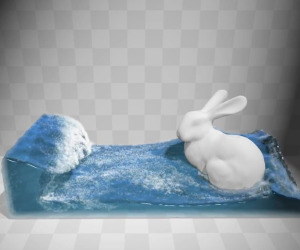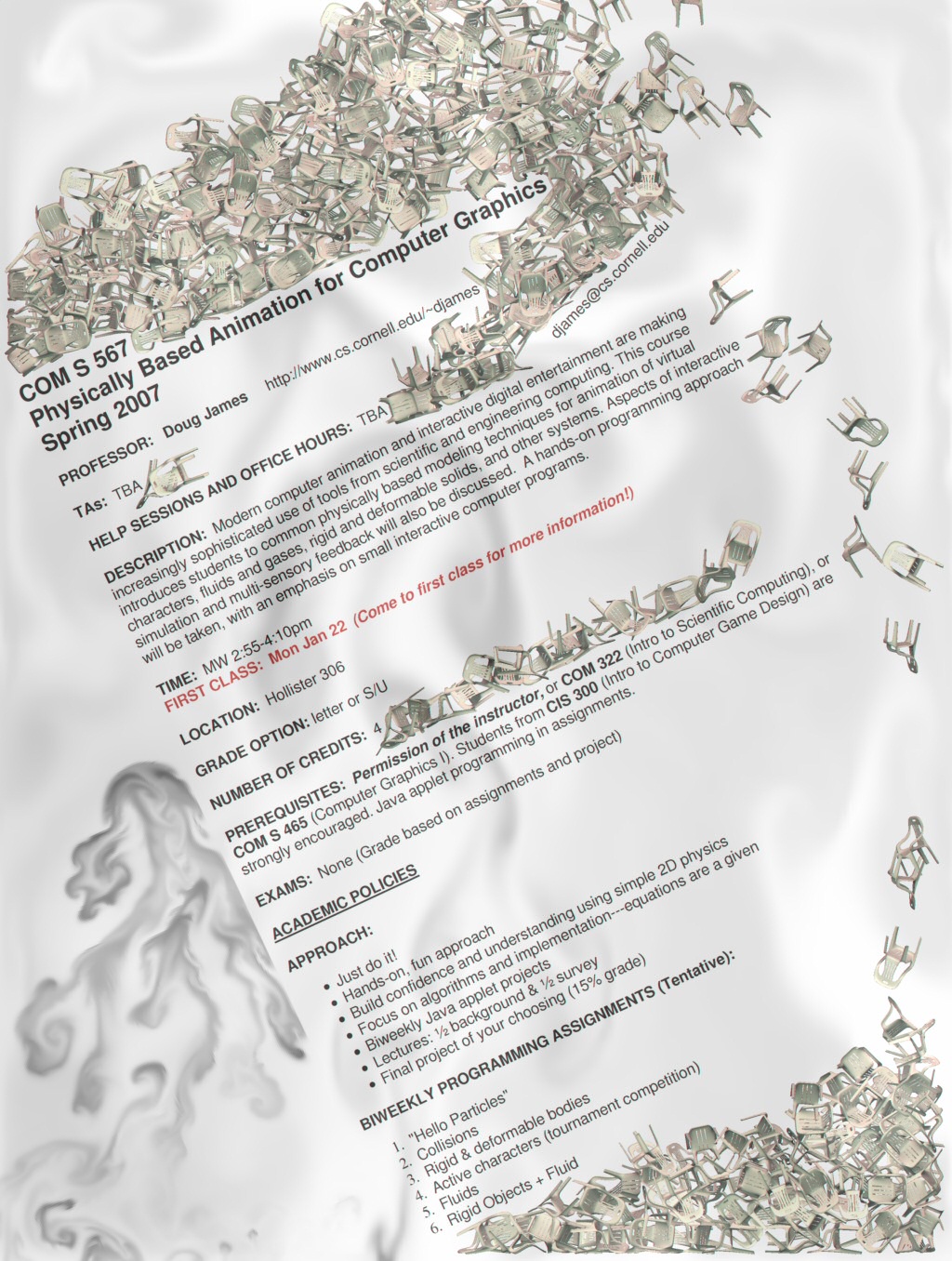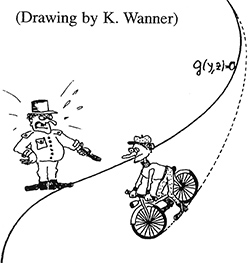| DATE |
TOPIC |
SUPPLEMENTAL MATERIALS
|
TuSep27
|
Introduction
|
Slides (PDF)
Readings:
|
ThSep29
|
Particle Systems
|
Material:
|
TuOct04
|
Constrained Dynamics
|
Material:
- Holonomic
constraints, C(p)=0.
- Example:
Bead on a wire
- Differentiating
constraints w.r.t. time.
- Constraint
Jacobian, J
- Lagrange
multipliers, lambda, and constraint forces, J^T lambda
- Solving
for Lagrange multipliers
- (Implicit
constraint (and half-explicit) DAE integration
schemes)
- Post-step
projection schemes
- Position- vs
velocity-based corrections
- Applications:
Mechanical linkages, inextensibility constraints,
incompressible flow, contact constraints
Written assignment: Particle
systems with holonomic constraints
References:
- David
Baraff and Andrew Witkin, Physically Based Modeling, Online
SIGGRAPH 2001 Course Notes, 2001.
- Examples from Cloth
Simulation:
- Rony Goldenthal, David
Harmon, Raanan Fattal, Michel Bercovier, Eitan
Grinspun, Efficient Simulation
of Inextensible Cloth, ACM Transactions on
Graphics, 26(3), July 2007, pp.
49:1-49:7. [ACM Digital Library link]
- Jonathan
M. Kaldor, Doug L. James, Steve
Marschner, Simulating Knitted
Cloth at the Yarn Level, ACM Transactions on
Graphics, 27(3), August 2008,
pp. 65:1-65:9.
[Advanced] References for
Differential-Algebraic Equations (DAEs):
|
ThOct06
TuOct11
|
Particle-based Fluids
![GPU-accelerated SPH [Harada et al.
2007]](http://www.cs.cornell.edu/courses/cs5643/2015sp/images/thumb_HaradaGPUSPH.jpg)
![OpenVDB [Museth; Dreamworks Animation]](images/thumb_museth.jpg)
|
Material:
- Smoothed Particle Hydrodynamics (SPH)
- Matthias Müller, David Charypar,
Markus Gross, Particle-based
fluid simulation for interactive applications, 2003
ACM SIGGRAPH / Eurographics Symposium on Computer
Animation (SCA 2003), August 2003, pp. 154-159. [Video]
- Miles
Macklin and Matthias Müller. Position
Based Fluids. ACM Trans. Graph. 32, 4,
Article 104 (July 2013), 12 pages. (other
videos)
- Liu, G. Gui-Rong, and M. B. Liu. Smoothed
particle hydrodynamics: a meshfree particle
method. World
Scientific, 2003.
- Wikipedia
- Takahiro Harada, Seiichi Koshizuka, Yoichiro
Kawaguchi, Smoothed Particle
Hydrodynamics on GPUs, Computer Graphics
International, pp. 63-70, 2007.
- B. Solenthaler, R. Pajarola, Predictive-Corrective
Incompressible SPH, ACM
Transactions on Graphics, 28(3), July 2009, pp. 40:1-40:6. [PDF]
[YouTube
Video]
- SIGGRAPH fluids course: [SPH
pages (pp.
83-86)]
- Bridson, R., Fedkiw, R., and Muller-Fischer, M.
2006. Fluid simulation:
SIGGRAPH 2006 course notes, In ACM
SIGGRAPH 2006 Courses (Boston, Massachusetts, July 30
- August 03, 2006). SIGGRAPH '06. ACM Press, New York,
NY, 1-87. [Slides, Notes]
- Robert
Bridson, Fluid Simulation for
Computer Graphics, A K Peters, 2008. [Book
format]
- Coupling SPH and rigid-body simulations (advanced):
- N. Akinci, M. Ihmsen, G. Akinci, B. Solenthaler, M.
Teschner, Versatile Rigid-Fluid
Coupling for Incompressible SPH, ACM
Trans. Graph. (SIGGRAPH Proc.), 2012. [PDF]
[AVI]
- Isosurface extraction + rendering
|
|
Prog. Assignment #1:
Position-Based Fluids

|
|
ThOct13
TuOct18
|
Implicit Integration
& Cloth Simulation
![[Baraff and Witkin 1998]](images/thumb_BW98.jpg)
|
Material:
- Blackboard
- Backward Euler method
- Stability analysis of
forward & backward Euler schemes on test problem
- Backward Euler for particle
systems
- Application to cloth
simulation [BW98]
- David
Baraff and Andrew Witkin, Physically Based Modeling, Online
SIGGRAPH 2001 Course Notes, 2001.
- Implicit Methods
(Baraff)
- David
Baraff, Andrew P. Witkin, Large
Steps in Cloth Simulation, Proceedings of SIGGRAPH
98, Computer Graphics Proceedings, Annual Conference
Series, July 1998, pp. 43-54.
- Implicit-Explicit (IMEX) integration
schemes:
- Ascher, Ruuth,
Wetton, Implicit-Explicit
Methods for Time-Dependent Partial
Differential Equations, SIAM J.
Num. Anal. 32, pp. 797-823, 1995.
- Bernhard
Eberhardt, Olaf Etzmuß, Michael Hauth, Implicit-Explicit
Schemes for Fast Animation with Particle
Systems, Computer Animation and
Simulation 2000, Proceedings of the EG Workshop in
Interlaken, 21-22 August, 2000.
- Example: "Going
implicit on damping"
|
TuOct18
ThOct20
|
Taking Derivatives:
From Tensor Calculus, to
Symbolic and Automatic Differentiation

|
Discussed differentiating
the following quantities with respect to particle position
vectors, p_i:
- constant, c
- position, p_j
- vectors, (p_j-p_k)
- distances, ||p_j-p_k||
- distance powers, ||p_j-p_k||^n
- functions of distance, W(||p_j-p_k||)
- dot products, (p_1-p_0)^T (p_3-p_2)
- cross products
- Example: hair bending energy derivative, E =
k*sin^2(theta/2) [handout]
[Mathematica]
Other topics:
|
ThOct20
|
Rigid-Body Dynamics
![Rigid Body Dynamics (from [Baraff 2001])](images/thumb_RBD.png)
|
References:
|
TuOct25
|
Application of Rigid-Body Motion:
Shape Matching Methods
![Pengchinko! [Rivers and James 2007]](images/thumb_fastlsmPenguins.jpg)
|
Discussed:
- Projecting
particle motion to be rigid motion
- Rigid-body
shape matching
- FastLSM
- Other
methods
(adaptive FastLSM; oriented particles)
Material:
- Matthias
Müller, Bruno Heidelberger, Matthias Teschner, Markus
Gross, Meshless deformations
based on shape matching, ACM Transactions on
Graphics, 24(3), August 2005, pp. 471-478. [ACM] [PDF] [AVI]
- Alec R.
Rivers, Doug L. James, FastLSM: Fast Lattice
Shape Matching for Robust Real-Time Deformation,
ACM Transactions on Graphics, 26(3), July 2007, pp.
82:1-82:6. [ACM] [PDF]
- Denis
Steinemann, Miguel A. Otaduy, Markus Gross, Fast Adaptive Shape
Matching Deformations, ACM
SIGGRAPH/Eurographics Symposium on Computer Animation,
Dublin, July 7-9, 2008. [PDF] [AVI]
- Matthias
Müller and Nuttapong Chentanez. Solid
simulation with oriented particles. ACM
Trans. Graph. 30, 4, Article 92 (July 2011), 10 pages,
2011. [ACM]
[PDF]
[MOVIE]
|
ThOct27
TuOct29
|
Position-Based Simulation
Methods
and other
relaxation-based dynamics
|
References:
- Jan. Bender, Matthias. Müller, Miles. Macklin, Position-Based Simulation
Methods in Computer Graphics, EUROGRAPHICS
Tutorial Notes, 2015, Zürich, May 4-8.
(Course Notes)(Slides)
- M. Müller, B. Heidelberger, M. Hennix, J. Ratcliff, Position
Based Dynamics, Proceedings
of Virtual Reality Interactions and Physical
Simulations (VRIPhys), pp 71-80, Madrid, November
6-7 2006, Best Paper Award, PDF, (video), (slides)
-
Miles
Macklin, Matthias Müller, Nuttapong Chentanez: XPBD: Position-Based
Simulation of Compliant Constrained Dynamics in Proceedings of ACM
Motion in Games, San Francisco, October
2016
[PDF][Slides][Video][Youtube] (An improved
PBD approach)
Other Reading:
- Jos Stam, Nucleus:
Towards a Unified Dynamics Solver for Computer
Graphics, 2009 Conference Proceedings: IEEE
International Conference on Computer-Aided Design and
Computer Graphics, pp. 1-11, 2009. (related talk)
- T. Jakobsen, Advanced
Character Physics, Game Developer
Conference, 2001.
- Miles Macklin, Matthias Müller, Nuttapong Chentanez,
and Tae-Yong Kim. 2014. Unified
particle physics for real-time applications. ACM Trans.
Graph. 33, 4, Article 153 (July 2014), 12 pages. [ACM
link]
- Sofien Bouaziz, Sebastian Martin, Tiantian Liu,
Ladislav Kavan, and Mark Pauly. 2014. Projective
dynamics: fusing constraint projections for fast
simulation. ACM Trans.
Graph. 33, 4, Article 154 (July 2014), 11 pages. [ACM
link]
- Rahul Narain,
Matthew Overby, George E. Brown, ADMM ⊇ Projective
Dynamics: Fast Simulation of General Constitutive
Models, ACM SIGGRAPH / Eurographics
Symposium on Computer Animation (SCA), 2016.
|
TuNov01
|
Prog. Assignment #2:
Position-Based Dynamics
![From [Muller et al. 2006]](images/thumb_posBasedDyn.jpg)
|
|
| TuNov01 |
Final Project + Proposal

|
|
ThNov03
|
Fracture Animation
![Fracture sound -- From [Chadwick et al. 2012]](images/thumb_fasterPAN_SCA2012.jpg)
|
Material:
- Demetri
Terzopoulos, Kurt Fleischer, Modeling
Inelastic Deformation: Viscoelasticity,
Plasticity, Fracture,Computer Graphics
(Proceedings of SIGGRAPH 88), August 1988, pp.
269-278.
- James F.
O'Brien, Jessica K. Hodgins, Graphical
Modeling and Animation of Brittle Fracture, Proceedings
of SIGGRAPH 99, Computer Graphics Proceedings,
Annual Conference Series, August 1999, pp.
137-146.
- James F.
O'Brien, Adam W. Bargteil, Jessica K. Hodgins, Graphical
Modeling and Animation of Ductile Fracture, ACM
Transactions on Graphics, 21(3), July 2002, pp.
291-294.
- Neil Molino,
Zhaosheng Bao, Ron Fedkiw, A
virtual node algorithm for changing mesh topology
during simulation, ACM
Transactions on Graphics, 23(3), August 2004,
pp. 385-392.
- M. Müller,
M. Gross, Interactive
Virtual Materials, in
Proceedings of Graphics Interface (GI 2004), pp
239-246, London, Ontario, Canada, May 17-19, 2004. (Video)
- Mark Pauly,
Richard Keiser, Bart Adams, Philip Dutré, Markus
Gross, Leonidas J. Guibas, Meshless
animation of fracturing solids, ACM
Transactions on Graphics, 24(3), August 2005,
pp. 957-964. [ACM]
(Video)
[PDF]
- Hayley N.
Iben, James F. O'Brien, Generating
Surface Crack Patterns, 2006
ACM SIGGRAPH / Eurographics Symposium on Computer
Animation, September 2006, pp. 177-186.
- Denis
Steinemann, Miguel A. Otaduy, Markus Gross, Fast
Arbitrary Splitting of Deforming Objects, 2006
ACM SIGGRAPH / Eurographics Symposium on Computer
Animation, September 2006, pp. 63-72. (Video)
- Bao, Z.,
Hong, J.-M., Teran, J. and Fedkiw, R., Fracturing
Rigid Materials, IEEE
TVCG 13, 370-378 (2007).
- Eftychios
Sifakis, Kevin G. Der, Ronald
Fedkiw, Arbitrary
Cutting of Deformable Tetrahedralized Objects,2007
ACM SIGGRAPH / Eurographics Symposium on Computer
Animation, August 2007, pp. 73-80.
- Eric G.
Parker and James F. O'Brien, Real-Time
Deformation and Fracture in a Game Environment, In
Proceedings of the ACM SIGGRAPH/Eurographics
Symposium on Computer Animation, pages 156–166,
August 2009.
- Su, J.,
Schroeder, C. and Fedkiw, R., Energy
Stability and Fracture for Frame Rate Rigid Body
Simulations,ACM SIGGRAPH/Eurographics
Symposium on Computer Animation (SCA), edited by
Eitan Grinspun and Jessica Hodgins, pp. 155-164
(2009).
- Changxi
Zheng, Doug L. James, Rigid-Body
Fracture Sound with Precomputed Soundbanks, ACM
Transactions on Graphics, 29(4), July 2010, pp.
69:1-69:13.
- M Müller, N
Chentanez, TY Kim, Real
time dynamic fracture with volumetric approximate
convex decompositions, ACM Transactions on
Graphics (TOG), 2013. [Video]
- Oleksiy
Busaryev, Tamal K. Dey, and Huamin Wang. 2013. Adaptive
fracture simulation of multi-layered thin plates. ACM
Trans. Graph. 32, 4, Article 52 (July 2013). [Video]
- Zhili Chen,
Miaojun Yao, Renguo Feng, and Huamin Wang. 2014. Physics-inspired
adaptive fracture refinement. ACM Trans.
Graph. 33, 4, Article 113 (July 2014). [ACM]
- Yufeng Zhu,
Robert Bridson, and Chen Greif, Simulating
Rigid Body Fracture with Surface Meshes, Transactions
on Graphics (Proc. ACM SIGGRAPH 2015).
- David Hahn
and Chris Wojtan, High-Resolution
Brittle Fracture Simulation with Boundary Elements,
ACM Trans. Graph. 34, 4, Article 151 (July 2015).
- David Hahn
and Chris Wojtan, Fast
approximations for boundary element based brittle
fracture simulation, ACM Trans. Graph.
35, 4, 104 (SIGGRAPH 2016).
- A recent
review of fracture in graphics:
|
TuNov08
ThNov10
|
Rigid-body Contact:
Impulse- and Contraint-based Methods:
|
Material:
- General
discussion of rigid-body contact principles (contact
constraints & impulses, restitution, Coulomb
friction, maximal dissipation principle,
Signorini-Fichera condition, connection with
constrained optimization & KKT conditions, etc.),
and methods such as impulse-based [Guendelman et al.
2003] and constraint-based [Erleben et al. 2007;
Kaufman et al. 2008] solvers.
- Two-body impulse calculation: See
Baraff course notes:
- Excellent recent
review:
- Impulse-based
contact solvers:
- Brian Mirtich,
John Canny, Impulse-based
Simulation of Rigid Bodies, 1995
Symposium on Interactive 3D Graphics, April 1995, pp. 181-188.
- Eran Guendelman, Robert Bridson,
Ronald P. Fedkiw, Nonconvex Rigid Bodies
With Stacking, ACM Transactions on
Graphics, 22(3), July 2003, pp. 871-878. [an iterative
impulse-based solver]
- Projected Gauss-Seidel solver:
- K.
Erleben, Stable, robust, and
versatile multibody dynamics animation. Ph.D.
thesis, Department of Computer Science, University
of Copenhagen, Denmark, 2005. [avi movie]
- K.
Erleben, Velocity-based shock
propagation for multibody dynamics animation,
ACM Trans. Graph. 26, 2, Jun. 2007.
- Projected
Jacobi solver:
- SIAM
Review of rigid-body contact:
- "Staggered Projections" method:
- A good reference on convex
optimization:
- Stephen
Boyd and Lieven Vandenberghe, Convex Optimization,
Cambridge University Press, 2004.
- Stanford
lecture notes/book [PDF]
|
TuNov15
|
Fluid Animation
|
Topics:
- Navier-Stokes
equations; Euler equations for inviscid fluids
- Advection;
semi-Lagrangian methods
- Splitting
schemes
- Incompressibility
constraint & divergence-free flow
- Helmholtz-Hodge
decompositions; pressure projection
- PIC/FLIP
methods [Zhu & Bridson 2005]
Materials:
- Bridson, R.,
Fedkiw, R., and Muller-Fischer, M. 2006. Fluid simulation:
SIGGRAPH 2006 course notes, In ACM
SIGGRAPH 2006 Courses (Boston, Massachusetts, July 30
- August 03, 2006). SIGGRAPH '06. ACM Press, New York,
NY, 1-87. [Slides, Notes]
(main reference for class)
- Jos Stam, Stable Fluids,
Proceedings of SIGGRAPH 99, Computer Graphics
Proceedings, Annual Conference Series, August 1999,
pp. 121-128. [Slides
and notes]
- Ronald
Fedkiw, Jos Stam, Henrik Wann Jensen, Visual Simulation of
Smoke, Proceedings of ACM SIGGRAPH
2001, Computer Graphics Proceedings, Annual Conference
Series, August 2001, pp. 15-22. (introduces vorticity confinement forces)
|
ThNov17
|
Guest Speaker
|
Guest Speaker:
Material:
Power Particles: An incompressible
fluid solver based on power diagrams
de Goes, Wallez,
Huang, Pavlov, Desbrun
SIGGRAPH / ACM
Transactions on Graphics (2015)
preprint video I video II dl.acm
|
TuNov22
ThNov24
|
Thanksgiving Break
(No classes)
|
|
TuNov29
|
No
class (Adobe-Stanford retreat)
|
|
ThDec01
|
Final-Project Working Class
|
- Come
to class prepared to discuss & work on your final
project
- Bring
questions
|
TuDec06
|
Noise & Turbulence Modeling
|
Materials:
- Ken Perlin and Eric Hoffert, Hypertexture, 1989 Computer Graphics (proceedings of ACM SIGGRAPH Conference), Vol. 22, No. 3. (Ken's write-up)
- Jos Stam and Eugene Fiume. 1993. Turbulent wind fields for gaseous phenomena. In
Proceedings of the 20th annual conference on Computer graphics and
interactive techniques (SIGGRAPH '93). ACM, New York, NY, USA, 369-376.
- Ronald Fedkiw, Jos Stam, Henrik Wann Jensen, Visual Simulation of Smoke,
Proceedings of ACM SIGGRAPH 2001, Computer Graphics Proceedings, Annual
Conference Series, August 2001, pp. 15-22. (introduces vorticity confinementforces)
- Jerry Tessendorf, Simulating Ocean Water, SIGGRAPH course notes, 2002. [Slides 2004]
- Frequency-domain methods commonly used for water wave simulation, e.g., NVIDIA WaveWorks.
- F. Neyret, Advected textures, In Proc. ACM SIGGRAPH/Eurographics Symp. Comp. Anim. (2003), pp. 147–153.
- Andrew Selle, Nick Rasmussen, Ronald Fedkiw, A vortex particle method for smoke, water and explosions, ACM SIGGRAPH 2005 Papers, July 31-August 04, 2005.
- Robert L. Cook and Tony DeRose. 2005. Wavelet noise. ACM Trans. Graph. 24, 3 (July 2005), 803-811. [ACM]
- Alexander Goldberg, Matthias Zwicker, Frédo Durand, Anisotropic noise, ACM Transactions on Graphics (TOG), v.27 n.3, August 2008.
- Robert Bridson, Jim Houriham, Marcus Nordenstam, Curl-noise for procedural fluid flow, ACM Transactions on Graphics (TOG), v.26 n.3, July 2007. (movie and public domain example code available.)
- Theodore Kim, Nils Thürey, Doug James, Markus Gross, Wavelet turbulence for fluid simulation, ACM Transactions on Graphics (TOG), v.27 n.3, August 2008. [ACM] (code available)
- H. Schechter, R. Bridson, Evolving sub-grid turbulence for smoke animation, Proceedings of the 2008 ACM SIGGRAPH/Eurographics Symposium on Computer Animation, July 07-09, 2008, Dublin, Ireland. [Movie]
- Rahul Narain, Jason Sewall, Mark Carlson, Ming C. Lin, Fast animation of turbulence using energy transport and procedural synthesis, ACM Transactions on Graphics (TOG), v.27 n.5, December 2008.
- Tobias Pfaff, Nils Thürey, Andrew Selle, and Markus Gross, Synthetic Turbulence using Artificial Boundary Layers,ACM SIGGRAPH Asia 2009 Papers, ACM Press, 2009.
|
ThDec08
|
Animation Sound
|
Material:
- K. van den Doel and D. K. Pai, The Sounds of Physical Shapes, Presence: Teleoperators and Virtual Environments, 7:4, The MIT Press, 1998. pp. 382--395.
- Kees van den Doel, Paul G. Kry, Dinesh K. Pai, FoleyAutomatic: Physically-Based Sound Effects for Interactive Simulation and Animation, Proceedings of ACM SIGGRAPH 2001, Computer Graphics Proceedings, Annual Conference Series, August 2001, pp. 537-544. [Video]
- Dinesh K. Pai, Kees van den Doel, Doug L. James, Jochen Lang, John E. Lloyd, Joshua L. Richmond, Som H. Yau, Scanning Physical Interaction Behavior of 3D Objects, Proceedings of ACM SIGGRAPH 2001, Computer Graphics Proceedings, Annual Conference Series, August 2001, pp. 87-96. [Video]
- James F. O'Brien, Perry R. Cook, Georg Essl, Synthesizing Sounds From Physically Based Motion, Proceedings of ACM SIGGRAPH 2001, Computer Graphics Proceedings, Annual Conference Series, August 2001, pp. 529-536.
- Perry R. Cook, Sound Production and Modeling, IEEE Computer Graphics & Applications, 22(4), July-August 2002, pp. 23-27.
- James F. O'Brien, Chen Shen, and Christine M. Gatchalian. Synthesizing sounds from rigid-body simulations. In The ACM SIGGRAPH 2002 Symposium on Computer Animation, pages 175–181. ACM Press, July 2002.
- Yoshinori Dobashi, Tsuyoshi Yamamoto, Tomoyuki Nishita, Real-Time Rendering of Aerodynamic Sound Using Sound Textures Based on Computational Fluid Dynamics, ACM Transactions on Graphics, 22(3), July 2003, pp. 732-740. [project page]
- Doug L. James, Jernej Barbić and Dinesh K. Pai, Precomputed Acoustic Transfer: Output-sensitive, accurate sound generation for geometrically complex vibration sources, ACM Transactions on Graphics, 25(3), pp. 987-995, July 2006, pp. 987-995.
- Changxi Zheng and Doug L. James, Harmonic Fluids, ACM Transaction on Graphics (SIGGRAPH 2009), 28(3), August 2009, pp. 37:1-37:12.
- Jeffrey Chadwick, Steven An, and Doug L. James, Harmonic Shells: A Practical Nonlinear Sound Model for Near-Rigid Thin Shells, ACM Transactions on Graphics (SIGGRAPH ASIA Conference Proceedings), 28(5), December 2009, pp. 119:1-119:10.
- Changxi Zheng and Doug L. James, Rigid-Body Fracture Sound with Precomputed Soundbanks, ACM Transactions on Graphics (SIGGRAPH 2010), 29(3), July 2010, pp. 69:1-69:13.
- Jeffrey Chadwick and Doug L. James, Animating Fire with Sound, ACM Transactions on Graphics, 30(4), August 2011.
- Jeffrey N. Chadwick, Changxi Zheng and Doug L. James, Precomputed Acceleration Noise for Improved Rigid-Body Sound, ACM Transactions on Graphics, August 2012.
- Steven S. An , Doug L. James, and Steve Marschner, Motion-driven Concatenative Synthesis of Cloth Sounds, ACM Transactions on Graphics, August 2012.
- Timothy R. Langlois and Doug L. James, Inverse-Foley Animation: Synchronizing rigid-body motions to sound, ACM Transactions on Graphics (SIGGRAPH 2014), 33(4), August 2014.
|
TuDec13
|
Final Project Due Date
|
Submit your project online via Canvas.
|
![Monsters Inc. [Pixar]](images/pixar_8999674.jpg)
![Yarn-level cloth simulation
[Yuksel et al. 2012]](images/thumb_StitchMeshes_teacozy.jpg)
![[Langlois and
James 2016]](images/thumb_Langlois2016.png)
![From [Bai et al. 2016]](images/thumb_Bai2016.png)
![Monsters Inc. [Pixar]](images/pixar_8999674.jpg)
![Yarn-level cloth simulation
[Yuksel et al. 2012]](images/thumb_StitchMeshes_teacozy.jpg)
![[Langlois and
James 2016]](images/thumb_Langlois2016.png)
![From [Bai et al. 2016]](images/thumb_Bai2016.png)



![GPU-accelerated SPH [Harada et al.
2007]](http://www.cs.cornell.edu/courses/cs5643/2015sp/images/thumb_HaradaGPUSPH.jpg)
![OpenVDB [Museth; Dreamworks Animation]](images/thumb_museth.jpg)

![[Baraff and Witkin 1998]](images/thumb_BW98.jpg)

![Rigid Body Dynamics (from [Baraff 2001])](images/thumb_RBD.png)
![Pengchinko! [Rivers and James 2007]](images/thumb_fastlsmPenguins.jpg)
![From Nucleus [Stam
2009]](images/thumb_pub_nucleus.jpg)
![From [Muller et al. 2006]](images/thumb_posBasedDyn.jpg)

![Fracture sound -- From [Chadwick et al. 2012]](images/thumb_fasterPAN_SCA2012.jpg)
![From [Erleben]](images/thumb_erleben.png)
![From [Kaufman et al. 2008]](images/card.png)
![From [Stam 1999]](images/thumb_stableFluids.png)
![From "Power
Particles" [de Goes et al. 2015]](images/thumb_pp.jpg)

![from [Kim et al. 2008]](http://www.cs.cornell.edu/%7Edjames/research/pics/Kim08.png)